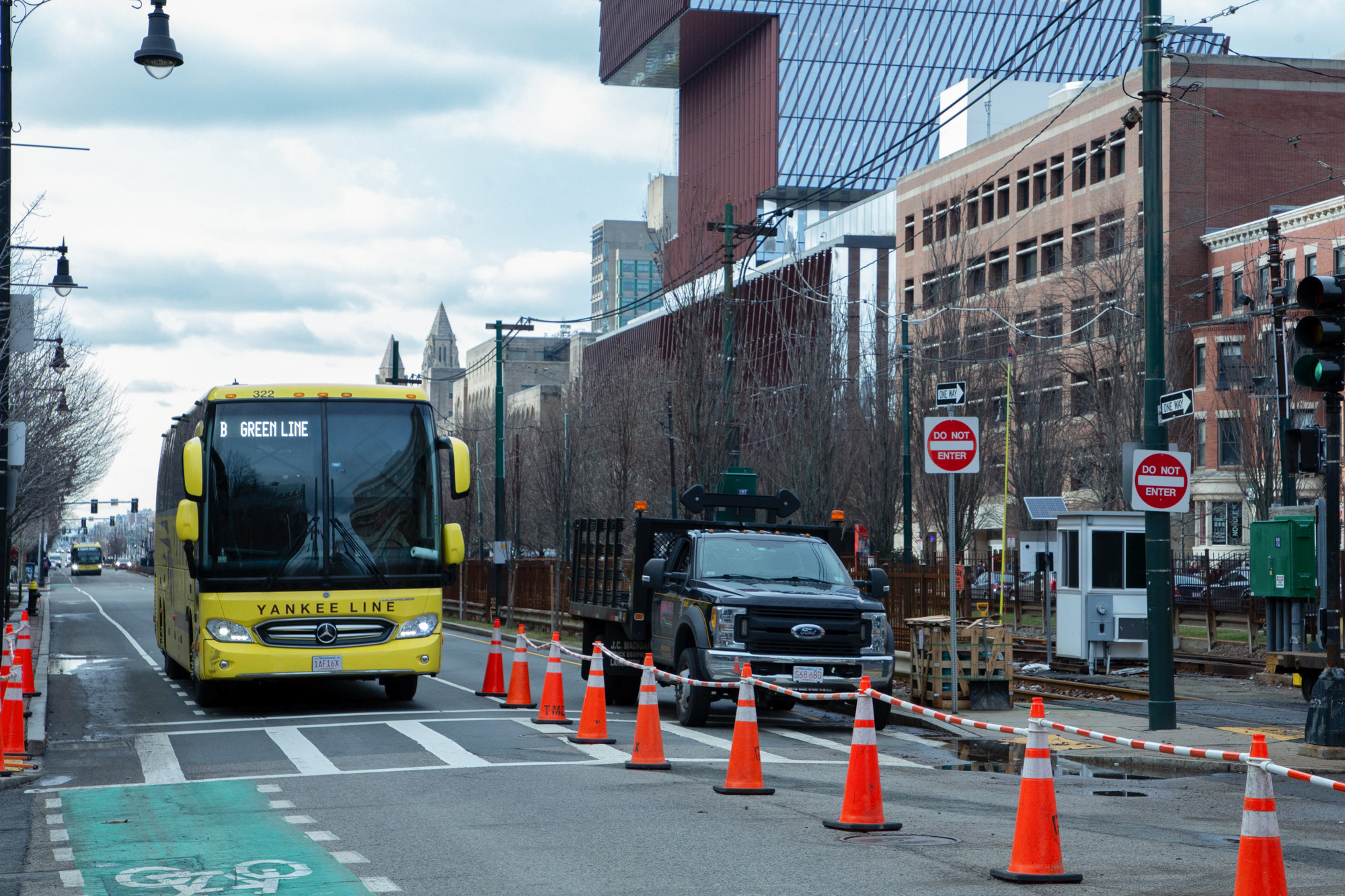Grab your bicycles, charge your scooters or stretch your legs. Just don’t expect the T to come down Commonwealth Avenue from Feb. 20 to March 8.

And nearly all MBTA Green Line C branch services will be suspended, as will service on the D branch from Copley to Brookline Hills. Shuttle buses will replace all trains and the Route 57 Bus will be free from Kenmore to Babcock St.
This is the fourth and longest suspension of service along B branch stations that serve Boston University since September, and is currently slated to be the longest in 2024. No trains ran through the Charles River Campus for days at a time in November, December and January.
MBTA officials say these service pauses help crews eliminate “speed restrictions” so trains can run faster and safer. Over a dozen slow zones were lifted since the surge in suspensions.
But no track work was needed between Kenmore and Babcock Street during the previous shutdown, according to MBTA spokesperson Lisa Battison, and there’s no plans for it in the next one.
Battison wrote in an email that there were two primary reasons for the outage.
“Blandford Street, the stop just before Kenmore, is a critical above-ground access point for maintenance vehicles to enter the underground Green Line tunnel,” Battiston wrote. “Second, Babcock Street is the last place where Green Line trains from Boston College can turn around and make an outbound trip.”
Battinson said crews did enhance the grade crossings between Blandford and Granby Streets, which includes BU’s Wheelock College and the Center for Computing and Data Sciences, and they plan to continue similar work in the next pause. This makes a smoother ride for the trains and cars at the crossings, she said.
Some students, who were excited to see the T running this semester, are disappointed to hear of another shutdown.
“I just like going in the city a lot and paying for Ubers is absolutely egregious now and walking all the way down there is also treacherous,” said Miranda Lemus, a junior in the College of Communication.
Modernizing Boston’s complicated, old and chronically underfunded subway system is a challenge, transit experts said.
“You’re going basically from a Model T to a Tesla,” said Keith Millhouse, former chairman of the board of directors for Metrolink, a commuter rail system in Southern California. “And that’s not easy to do.”
Trains on the Green Line run through North America’s oldest underground subway tunnel, where all four branches merge on two tracks.
“There’s just not any extra space. There’s no extra tracks,” said Eric Gonzales, professor of civil and environmental engineering at University of Massachusetts Amherst. “It takes a different level of care to work in a 125-year-old tunnel than it does in something that’s newer.”
And without many switches for trains to turn around, it’s not as easy to keep trains running while crews work on select tracks, Millhouse said.
“The more options you have, the greater flexibility you’ll have when you go to either maintain or improve the system,” he said.
Instead of more closures during nights and weekends, MBTA officials say longer closures let crews get more work done with unrestricted access.
“Certainly the pace and number of them is pretty unprecedented,” said Jarred Johnson, executive director of TransitMatters, a Massachusetts public transportation advocacy group. “It does mean though, that it is really hard to make each diversion great from the rider experience.”
The Green Line also struggles to be as reliable as the Red, Orange and Blue lines, according to data posted by the transit authority. Unlike those lines, portions of the Green Line operate at street-level, slowing for pedestrians and stopping at red lights.
Ella Reed, a freshman in the Pardee School of Global Studies who works at FitRec, says the shuttles’ unpredictable timing make it difficult to get to work on time.
“I never know when they show up,” Reed said. “So if I’m waiting for a shuttle to go to FitRec, I could be late, I could not be late, I never know.”
Hattie Maxwell, a freshman in COM, said while she loves how “cozy and big” the shuttle buses are, their timing has made her late many times.
BU students also have free access to the Boston University Shuttle (BUS), which runs throughout campus. Johnson says this extra form of transit makes the shutdowns not as dramatic as it is in other areas of Boston, where there may not be such alternatives.
Still, some students say the BUS has its own scheduling problems.
“The BU bus … app is probably the worst designed thing I’ve ever seen in my life,” said Lemus.
Lemus said the BUS is often crowded, especially when many classes finish and “everybody’s traveling from place to place.” Lemus said two of her friends were split up once, with one of them on the bus and another unable to board.
“It’s funny to laugh on, but in reality they do get places late and it’s really inconvenient,” Lemus said.
Christina Chen, a freshman in COM, said she was excited to see the Green Line running again after the most recent shutdown.
“We saw it running down Commonwealth and we were screaming with joy,” said Chen. “The fact that it’s gonna shut down so soon again is kind of inconvenient.”























































































































